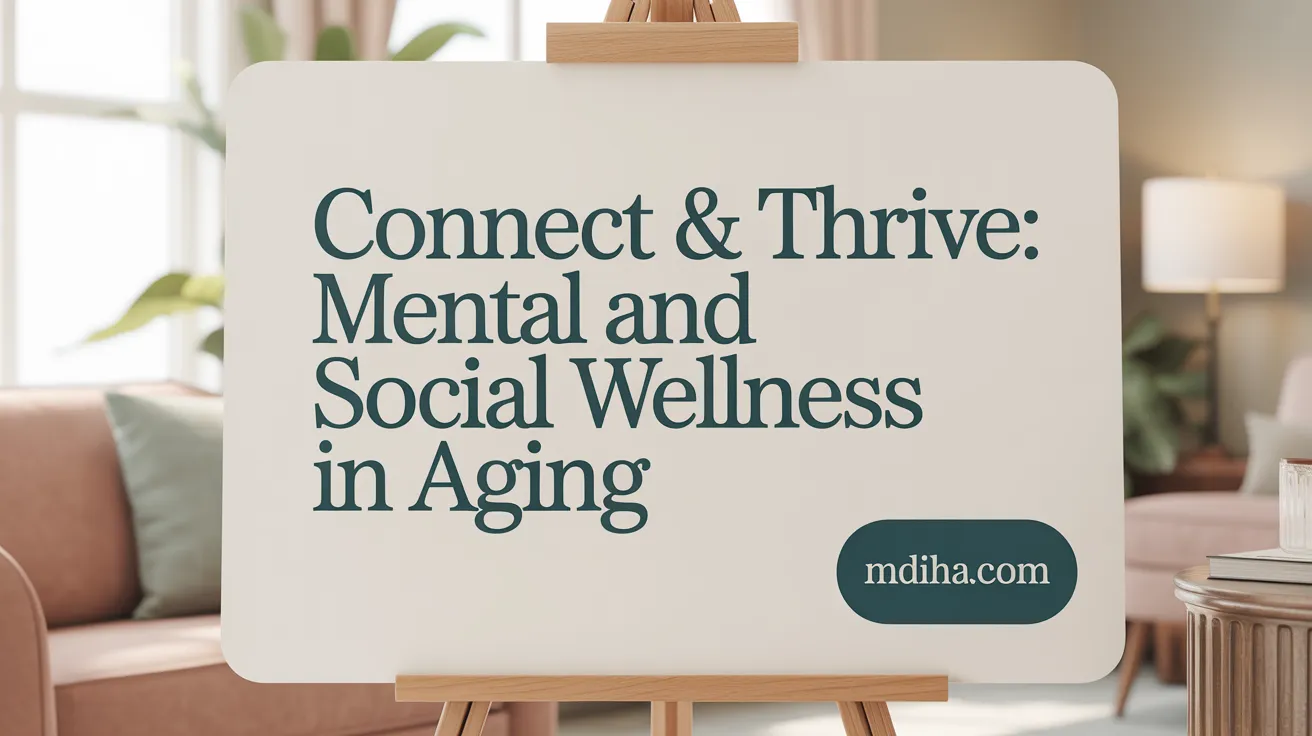Embracing Healthy Aging at Every Stage
Healthy aging is a multifaceted journey that begins from the earliest days of life and continues well into older adulthood. Promoting health and longevity across different life stages requires tailored strategies that encompass lifestyle choices, healthcare interventions, and supportive environments. This article explores effective approaches to fostering vibrant health and independence throughout the life course, emphasizing the importance of nutrition, physical activity, mental well-being, social connections, and innovative healthcare practices.
Foundations of Healthy Aging in Early Life and Beyond

How do early life factors influence healthy aging?
Healthy aging begins in the earliest stages of life. The first 1000 days—from conception through age two—are crucial for establishing the foundation for lifelong health. During this period, proper nutrition and development strongly influence physical growth and cognitive function. Habits formed early, such as breastfeeding and nutrient-rich diets, reduce the risk of chronic diseases later in life, setting a trajectory for healthier aging.
What lifestyle factors contribute to increased longevity?
Research from regions known as Blue Zones identifies several lifestyle practices linked to longer, healthier lives. These include diets rich in plant-based foods consistent with the Mediterranean diet, which emphasizes fruits, vegetables, whole grains, nuts, and healthy fats like olive oil. Moderate caloric intake, regular physical activities such as walking and gardening, maintaining strong social relationships, cultivating a sense of purpose, and managing stress effectively are all associated with improved healthspan and longevity.
What impact do early interventions have on later health?
Intervening early with tailored nutrition, healthcare screenings, vaccinations, and promoting healthy behaviors can significantly affect health outcomes in older age. Early life interventions, coupled with continued support across the lifespan—such as encouraging physical activity and social engagement—help prevent the accumulation of chronic diseases and functional decline. This comprehensive approach nurtures both lifespan and healthspan, encouraging independence and quality of life in later years.
Nutrition: Tailoring Diet to Support Healthy Aging Across Life Stages
How Should Nutrition Be Adapted for Healthy Aging?
Nutrition needs change significantly with age. As people grow older, their calorie requirements typically decrease due to reduced physical activity and metabolic changes. However, the demand for essential nutrients such as protein, calcium, vitamin D, vitamin B12, potassium, and dietary fiber remains the same or even increases. This makes consuming nutrient-rich foods vital for maintaining muscle mass, bone strength, cognitive function, and overall health (Nutrition as We Age, Nutrition Tips for Older Adults, The Changing Nutritional Needs of Older Adults and How to Meet Them).
Older adults are encouraged to eat a balanced diet featuring a variety of whole foods, including fruits, vegetables, whole grains, lean proteins like fish and poultry, low-fat dairy products, nuts, and seeds. Limiting intake of empty calories from processed foods high in added sugars, unhealthy fats, and sodium reduces the risk of chronic diseases common in aging populations (Healthy Eating Tips for Seniors, Healthy Aging).
What Challenges Affect Nutritional Status in Older Adults?
Several factors can hinder healthy eating habits among older adults. These include diminished appetite often caused by physiological changes, alterations in taste and smell, dental or chewing difficulties, side effects from medications, limited mobility, and economic constraints. Furthermore, social isolation can reduce motivation to prepare and consume balanced meals (Improving Nutrition in Elderly, Nutrition Concerns for Aging Populations).
Strategies to Overcome Nutrition-Related Challenges
Practical approaches to support better nutrition include sharing meals with others to promote social engagement, planning meals ahead, and ensuring food safety through proper storage and preparation. Nutritional screening tools can identify at-risk individuals, enabling timely interventions. Utilizing community resources such as nutrition assistance programs (e.g., SNAP), congregate meal services, and home-delivered meal options offers helpful support (Nutrition as We Age, Healthy Aging).
Focusing on nutrient-dense food choices tailored to individual needs, combined with regular physical activity to stimulate appetite and metabolic health, ensures healthier aging through optimal nutrition across life stages (Physical Activity Recommendations for Seniors, Live Long & Be Well: Science-Based Tips for Healthy Aging).
Physical Activity: Vital for Health and Independence from Childhood to Older Age

What are the physical activity guidelines for various life stages?
Physical activity recommendations vary with age to support growth, development, and healthy aging. Children and adolescents should engage in at least 60 minutes of moderate to vigorous physical activity every day. This includes aerobic exercises alongside muscle- and bone-strengthening activities to build fitness and bone health (source).
Adults aged 18 to 64 are advised to aim for a minimum of 150 minutes per week of moderate-intensity exercise (like brisk walking) or 75 minutes of vigorous activity (such as running), supplemented by muscle-strengthening exercises twice weekly. This routine supports cardiovascular health, strength, and metabolic function (source).
Older adults (65 years and above) follow similar guidelines for aerobic and strength activities but also emphasize balance and flexibility exercises to reduce the risk of falls. Activities such as tai chi, standing on one foot, and gentle yoga are recommended three or more times weekly to maintain stability and prevent injuries (source).
How does physical activity benefit health during aging?
Regular physical activity plays a crucial role in maintaining independence and quality of life as people age. It helps preserve cardiovascular health by reducing hypertension and mitigating heart disease risk. Strength training sustains muscle mass, combatting sarcopenia, while weight-bearing exercises maintain bone density, lowering fracture risk (source).
Exercise also supports flexibility and coordination, preventing falls – a leading cause of injury among older adults. Activities like walking, swimming, gardening, and yoga contribute to mobility and functional independence (source).
Moreover, physical activity benefits mental health by enhancing cognitive function, reducing the incidence of depression and dementia. Engaging in regular exercise improves sleep quality and stress management, supporting overall well-being (source.
By adopting age-appropriate physical activity routines, individuals at every stage from childhood through older adulthood can significantly enhance their health, prevent chronic conditions, and maintain autonomy (source).
Mental and Social Well-being: Cornerstones of Healthy Aging

Why is social engagement vital for aging well?
Social connections and active community involvement significantly benefit older adults. They reduce the risk of depression, slow cognitive decline, lower cardiovascular disease risk, and decrease overall mortality rates. Being socially engaged fosters emotional well-being by providing a sense of purpose and belonging, which are critical to living a longer, healthier life (social connections and aging, social engagement benefits, strong social connections in aging).
What mental health issues affect older adults and how can they be addressed?
Older adults commonly face mental health challenges such as depression, anxiety, mild cognitive impairment, and dementia. Unfortunately, these issues are often underdiagnosed and undertreated. Addressing them involves early detection through routine mental health screenings and increasing access to specialized care (mental health promotion strategies for elderly, mental health support for older adults). Managing stress through practices like meditation, yoga, and mindfulness further supports emotional health (stress management for seniors, exercise and meditation for stress. Additionally, engaging in mentally stimulating activities—like learning new skills or joining clubs—helps maintain cognitive function and emotional balance (lifelong learning and hobbies, mental stimulation).
Strategies for maintaining cognitive and emotional health
Maintaining cognitive and emotional health in older adults requires a multifaceted approach. Social interaction is essential and can be enhanced through family support, community groups, or volunteer opportunities (community support for elderly health, social engagement for mental health). Stress reduction techniques and regular physical activity also contribute positively (physical activity benefits, stress management techniques. Lifelong learning and hobbies encourage brain engagement, slowing cognitive decline (cognitive benefits of hobbies, learning new skills. Getting adequate sleep and addressing any mental health symptoms promptly with professional help ensures better outcomes (importance of quality sleep, mental health screenings for older adults. Together, these strategies create a resilient foundation for mental and social well-being throughout aging.
Healthcare Interventions and Public Policy to Support Healthy Aging

How do healthcare interventions contribute to healthy aging?
Healthcare interventions play a vital role in supporting older adults to maintain their health and independence. Key strategies include promoting health literacy, which empowers individuals to make informed decisions about their wellbeing. Vaccination programs protect against infections that can have severe consequences in aging populations, such as influenza and pneumonia.
Regular screenings and medical check-ups enable early detection and management of chronic diseases like cardiovascular disease, cancer, and cognitive decline. Early intervention can reduce complications, prevent hospitalizations, and improve quality of life. These healthcare measures support sustained function and independence among older adults.
What public policy measures support healthy aging communities?
Public policies significantly shape conditions for healthy aging. Environmental measures to reduce pollution and mitigate climate change address risk factors that disproportionately impact older adults. Designing age-friendly cities with accessible public spaces, transportation, and housing fosters mobility and social participation.
The UN Decade of Healthy Ageing (2021–2030) sets a global framework that promotes combating ageism, enhancing community support, and improving access to quality care. Coordinated public health programs incorporating these policy goals help create supportive environments for aging populations.
Role of health literacy, age-friendly environments, and policy
Improving health literacy ensures older adults understand preventive care and treatment options, enhancing adherence to health recommendations. Age-friendly environments facilitate engagement in physical activities, social connections, and access to services, critical for overall health.
Policies that integrate healthcare services with environmental planning and community support foster longer, healthier, and more independent lives for older adults. These multidimensional efforts are essential to meet the challenges of growing aging populations worldwide.
Innovations and Personalized Approaches in Healthy Aging

What novel scientific approaches are advancing healthy aging?
Recent advances in geroscience research on aging are revolutionizing our understanding of aging by focusing on the biological mechanisms that underlie this complex process. Interventions like metformin and rapamycin aging interventions are at the forefront, showing promise in delaying the onset and progression of age-related diseases. These compounds target pathways involved in cellular aging, potentially extending the healthspan—the period of life spent in good health.
In parallel, digital health technologies in aging are transforming care delivery for older adults. Artificial intelligence in personalized health and digital twins for elderly care enable comprehensive analysis of multifactorial aging processes, allowing for the design of personalized treatment plans. These technologies process vast amounts of individual health data to identify risk factors and optimize interventions tailored to an individual's unique biological and lifestyle profile.
How do personalized interventions enhance healthy aging?
Personalized interventions leverage individual genetics, environmental exposures, and behavioral factors to customize health strategies. By integrating precision medicine and advanced data analytics, healthcare providers can target prevention, diagnosis, and treatment more effectively than ever before.
This approach moves beyond one-size-fits-all models, adapting recommendations for diet, physical activity, medication, and monitoring to suit each person's needs. When combined with traditional public health strategies for aging measures and community support for elderly health, personalized care fosters healthier aging trajectories, reduces chronic disease burden, and supports independence in older populations.
The synergy between emerging scientific research and technological innovation is critical for the future of healthy aging, promising to extend both lifespan and quality of life through targeted, data-driven strategies.
A Lifelong Commitment to Healthy Aging
Healthy aging is an ongoing process that spans from early development through older adulthood, necessitating a holistic approach that integrates proper nutrition, consistent physical activity, mental and social well-being, effective healthcare, supportive public policies, and innovative scientific advances. By embracing age-appropriate strategies and fostering environments that promote health and independence, individuals and societies can enhance quality of life and extend healthspan. The future of aging promises greater personalization through technology and research, ensuring that healthy living is attainable at every stage of the lifespan.
